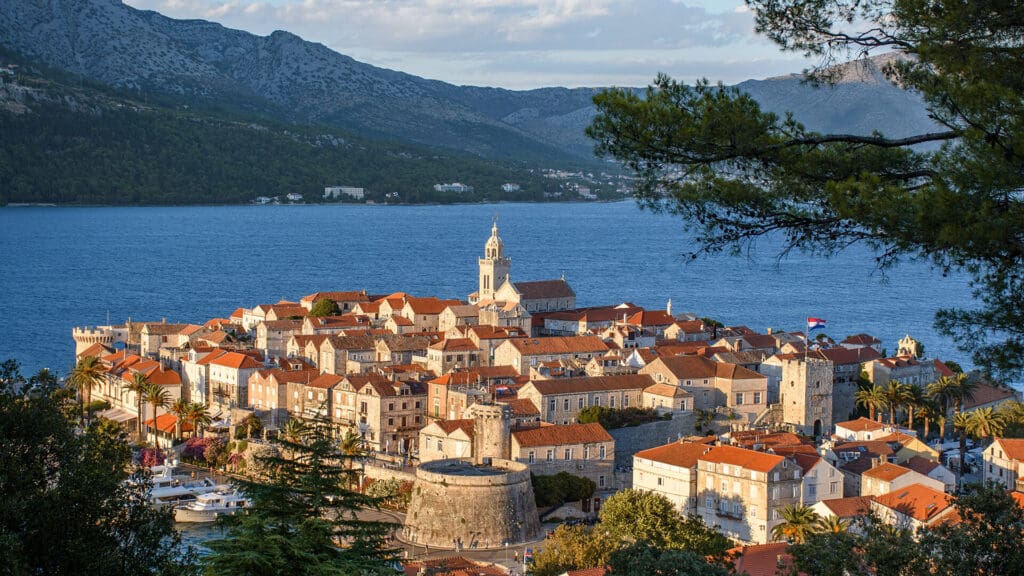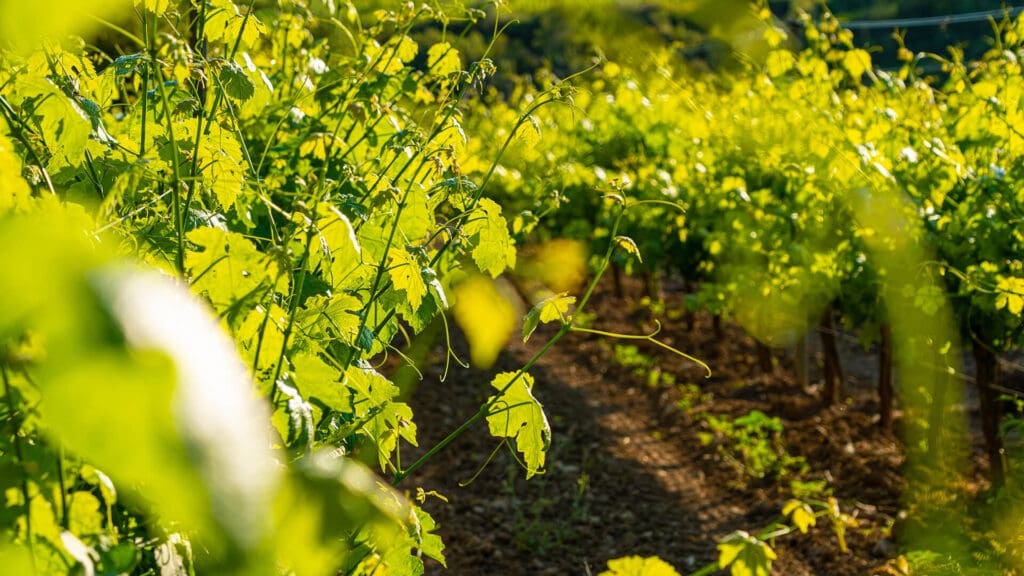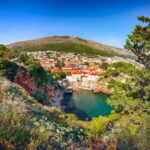Traveling to Dubrovnik this summer? Then a period of luxury lies ahead! Few places on Earth offer such a winning blend of breathtaking natural landscapes, historical marvels, and first-class food and drink.
Wine aficionados are especially in luck. Dalmatia has a long history of viticulture and produces some truly splendid wines. In addition to the superior quality of the wine, there’s also the superior setting in which to drink it! Imagine yourself relaxing on a quiet, leafy island, sipping a glass of locally-produced wine.
Join us as we explore three wines we recommend anyone try while they are in Dubrovnik.
We hope the following blog provides you with lots of inspiration for your forthcoming travels. Before you go, please consider joining us for a Luxury Boat Tour from Dubrovnik.

Grk
Grk, a white grape variety native to Dalmatia, boasts a lineage rooted in the sandy soils of Lumbarda, a quaint village on Korčula Island. Esteemed for its rarity and distinctive flavor profile, Grk has carved a niche within Croatia’s viticultural heritage. This variety, intriguingly named after the Croatian word for ‘bitter,’ defies its moniker with a wine that is anything but. The essence of Grk wine is a harmonious blend of dryness and high acidity, laced with aromatic nuances and hints of pine, setting it apart in the realm of white wines.
Cultivated in an area historically untouched by the phylloxera epidemic that ravaged many European vineyards, Grk’s survival speaks to its resilience and uniqueness. Contrary to what its name might suggest, Grk does not have its origins in Greek viticulture, nor does it share a genetic link with the Italian Greco grape. Instead, it belongs to Croatia’s indigenous viticulture and is closely related to Tribidrag.

Grk’s cultivation is a tale of adaptation and specificity, thriving in the rocky and sandy terrain near Lumbarda’s coastline. This proximity to the sea imparts the wine with a crisp, fruity profile and a slight briny undertone, a testament to the vine’s ability to capture the essence of its surroundings. Grk wine, primarily dry, is also available in sparkling and mature varieties.
What sets Grk apart is not only its flavor but its reproductive uniqueness. As a variety with only female functional parts, Grk relies on cross-pollination with neighboring grape varieties, such as Plavac Mali, for fruit production. This interdependency highlights a symbiotic relationship crucial for the cultivation of this exceptional wine.
In terms of taste, Grk wine diverges significantly from its ‘bitter’ linguistic roots, offering instead a palate of moderate aroma, ripe fruit, citrus, and herbal notes, with mild bitterness and a smooth mouthfeel that evolves with aging. Its unique salinity and minerality, coupled with a complex flavor profile reminiscent of Chardonnay’s richness, Sauvignon Blanc’s aromatics, and Riesling’s acidity, make Grk a standout in the wine world.
Want to see Korcula for yourself? Book a luxury Speedboat Transfer from Dubrovnik.

Plavac Mali
The King of Croatian Reds, Plavac Mali, is a cornerstone of Croatia’s viticultural identity, particularly revered along the Dalmatian coast. This grape variety is the progeny of Crljenak Kaštelanski (the ancestor of Zinfandel) and Dobričić grapes, melding the robust qualities of both to produce wines of remarkable depth and intensity. The name Plavac Mali, translating to “small blue,” references the diminutive, deeply colored grapes it yields, indicative of the rich, full-bodied wines they become.
Characterized by its resilience and adaptability, Plavac Mali thrives in the karst landscapes of Dalmatia, where it dominates the red wine scene. Its wines are celebrated for their potent alcohol content, often ranging between 13% to 17%, and their pronounced tannic structure. This robust framework supports a complex bouquet of aromas and flavors including carob, figs, sage, and a melange of dark fruits and spices, creating a sensorial experience that is distinctly Mediterranean.
Plavac Mali’s nuanced profile is a testament to its terroir-driven nature, with each vineyard imparting a unique stamp on the wine. Renowned regions such as Dingač and Postup on the Pelješac Peninsula, alongside the islands of Hvar, Brač, and Vis, each contribute divergent expressions of Plavac Mali, ranging from powerful and tannic to more fruit-forward and approachable iterations.
This diversity is further enriched by the grape’s versatility, manifesting in dry, semi-dry, and sweet variants that cater to a wide spectrum of palates.
However, Plavac Mali’s vigor comes with challenges, notably its propensity for uneven ripening. This characteristic can lead to a delicate balance in winemaking, where achieving optimal ripeness without compromising the grape’s natural acidity and tannin becomes a skilled art. Moreover, the grape’s history is intertwined with the broader narrative of viticulture, as DNA research has revealed its ties to Zinfandel, offering a fascinating glimpse into the migratory paths of grape varieties.
The grape’s capacity for aging is notable, with high-quality Plavac Mali wines demonstrating significant development over time. These wines can evolve to exhibit softer tannins, deeper flavors, and increased complexity, rewarding patient collectors. This aging potential, combined with the grape’s rich flavor profile and structural heft, cements Plavac Mali’s status as a flagship of Croatian wine, embodying the essence of its Dalmatian origins.
Want to do some island hopping? Consider booking a place on our Elaphiti Islands Tour or Wine and Food Tour of the Elaphitis.

Pošip
Pošip, another distinguished white wine grape originating from Croatia’s idyllic island of Korčula, presents a compelling story of discovery and heritage. With its roots in the fertile soils of Čara and Smokvica, two picturesque villages on Korčula, Pošip has gained acclaim for its expressive and flavorful wines. This grape variety stands out not only for its historical significance but also for being the first native Croatian white wine to receive a controlled designation of origin in 1967, a testament to its unique character and the dedication of its cultivators.
The genesis of Pošip is as fascinating as its flavor profile. Through DNA analysis, it has been revealed to be a cross between two local varieties, Bratovina and Blatska Zlatarica, highlighting the natural biodiversity and viticultural heritage of the Dalmatian region. Pošip wines are celebrated for their aromatic intensity and complexity, offering a palette of flavors that capture the essence of the Mediterranean landscape.
Over the years, the cultivation of Pošip has expanded beyond the confines of Korčula, finding new terrains across the southern Dalmatian region. This expansion is a reflection of the grape’s versatility and the growing interest in exploring and preserving indigenous Croatian varieties. From the steep slopes of Pelješac and Biokovo to the vibrant islands of Hvar and Brač, and even to the mainland regions like Petrčane near Zadar and the hinterlands of Skradin, Komarna, and Konavle, Pošip has proven its adaptability and appeal.
The resilience of Pošip is also notable, having survived the phylloxera epidemic that devastated many European vineyards. Its ability to thrive in the sandy soils of Smokvica, where it is still grown on its original rootstock, speaks volumes about its robustness and the careful stewardship of the vineyards by local winegrowers.
Pošip wines are ideal for a variety of food pairings, especially with seafood, thanks to their rich aromatic profile and balanced acidity. Whether it’s an octopus salad, smoked white fish, or a more hearty dish like roasted chicken, Pošip brings a refreshing and harmonious complement to the table.
This brings an end to our short list of must-try Croatian wines. If you have any questions, please get in touch.





